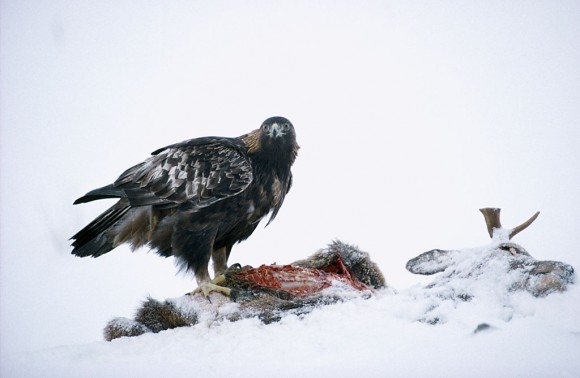Scientific name: Aquila chrysaetos
Identification
Adult golden eagles are dark brown with a golden sheen on the top of the head and neck. Juveniles have a white base to their tail and white patches on the undersides of their wings, meaning they can sometimes be confused with the white-tailed eagle. However, the best diagnostic tool is the shape of the tail: distinctively wedge-shaped in white-tailed eagles but just slightly rounded in golden eagles. From a distance adults can also sometimes be confused with buzzards, however golden eagles are much bigger, with a wing span of up to 2 metres, almost twice that of a buzzard. The tail is also longer than a buzzard’s and the head protrudes more prominently in front of the wings. They have a yellow base to their powerful bill, and yellow legs and talons. In flight the wings are spread in a slight ‘V’ and the tips are spread like fingers.
Habitat and Distribution
In Scotland they inhabit mountains, high moorlands and remote islands, but before persecution by man would have been much more widely distributed. The golden eagle has a very wide distribution, being found across much of the Northern Hemisphere. Within the UK its stronghold is Scotland, and is found mainly in the Scottish Highlands and islands. It has recently been reintroduced to Ireland, but remains absent from Wales and is found only in very small numbers in northern England.
Diet
Golden eagles take a range of prey items, both birds and mammals. Most commonly they feed on medium-sized prey such as rabbits, hares, grouse and ptarmigan, but also take young deer, as well as scavenging on carrion. Pine martens,, foxes, water voles and adders have also been reported as prey items.
Reproduction
Golden eagles do not usually breed until 4 years of age or more. An eyrie built of sticks is constructed on a remote cliff ledge or in the top of a mature tree, although they prefer to use existing nests. Eyries are huge structures, frequently being at least 2m wide and deep. The female lays 1-2 eggs in late March-early April and incubates for 43-45 days. The male shares incubation but it is mainly carried out by the female. There is normally a noticeable size difference in the chicks due to the eggs being laid over a few days, and the older chick may kill its younger sibling, especially when food is scarce. Both adults feed the chicks and the young fledge after about 65 days. They continue to be fed for a further three months or so, and then leave their natal territory sometime in the autumn or winter. Young eagles roam widely in their first years of life, before finding a vacant territory and mate. They are monogamous and mate for life.
Status and threats
Golden eagles are classified by the World Conservation Union (IUCN) as ‘Least Concern’. However, although they are widely distributed across the globe, they have suffered huge declines due to persecution and, sadly, this continues today, with poisoning being the most common form of killing. As with many other raptors, golden eagles were badly affected in the 1950s and 1960s by organochlorine pesticides such as DDT, which caused thinning of eggshells and so caused a huge decrease in reproductive success. Within Scotland many former territories remain uncolonised, mainly due to illegal persecution and in parts of the Western Highlands due to ecological degradation and reductions in food availability.
Within the UK they are strictly protected under Schedule 1 of the Wildlife and Countryside Act 1981 and The Nature Conservation (Scotland) Act 2004. They are also included on the Amber List of UK birds of conservation concern. It is an offence to intentionally take, injure or kill a golden eagle or to take, damage or destroy its nest, eggs or young. It is also an offence to intentionally or recklessly disturb the birds close to their nest during the breeding season. Violation can result in a fine of up to £5000 and/or a prison sentence of up to 6 months.

















